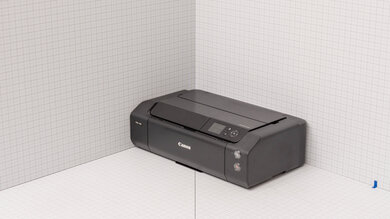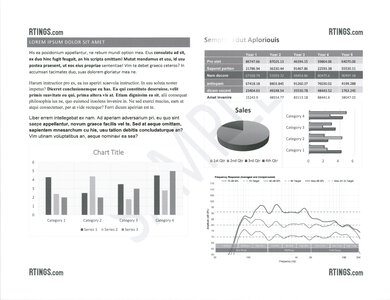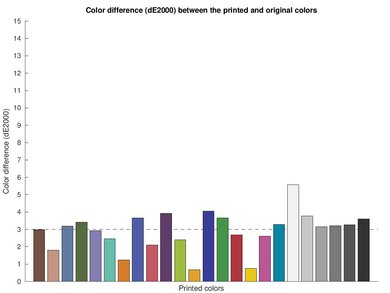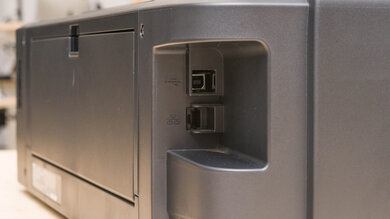The Canon imagePROGRAF PRO-300 is an inkjet print-only unit designed for professional photo printing. Unlike most general-purpose inkjet office printers, it uses a total of ten ink cartridges, including a Chroma Optimizer, which coats and seals photos to improve longevity and shine. It connects via USB, Wi-Fi, or Ethernet, supports Apple AirPrint and Mopria Print Service, and is compatible with Canon's PRINT Inkjet/SELPHY mobile app.
Our Verdict
The Canon imagePROGRAF PRO-300 is okay for family use. It has wide connectivity options, making it easy for every household member to access. It produces amazingly sharp documents as well as detailed and colorful photos; however, it's rather slow, so it isn't ideal for high-volume printing. It doesn't yield many black prints, meaning you'll have to replace the black cartridge often, and while its color page yield is better, color ink cartridges are expensive, so it can get very expensive to maintain if you print a lot. It also lacks a scanner and doesn't support automatic duplex printing.
- Produces detailed and colorful photos.
- Offers great built-in maintenance programs.
- Very low cost-per-print for black-only printing.
- Wide connectivity options.
- Extremely slow print speed.
- No scanner.
- Low black page yields.
- Color printing is expensive.
The Canon imagePROGRAF PRO-300 is sub-par for home office use. It doesn't have a scanner, and it can't perform automatic duplex printing, so you'll have to flip the pages manually when printing double-sided. Also, it takes over a minute to produce the first page of a document, and subsequent pages aren't much faster.
- Offers great built-in maintenance programs.
- Very low cost-per-print for black-only printing.
- Wide connectivity options.
- Extremely slow print speed.
- No scanner.
- Low black page yields.
- Color printing is expensive.
The Canon imagePROGRAF PRO-300 is okay for student use. Its black page yield isn't very high, but since its ink is relatively cheap to replace, the cost-per-print remains decent. For photography or graphic design students, it has excellent color accuracy and produces outstanding photos. Unfortunately, it takes over a minute to produce the first page, and subsequent pages don't print much faster. It also lacks a scanner for digitizing class notes or other documents.
- Excellent color accuracy.
- Very low cost-per-print for black-only printing.
- Wide connectivity options.
- Feature-rich mobile app.
- Extremely slow print speed.
- No scanner.
- Low black page yields.
- Color printing is expensive.
The Canon imagePROGRAF PRO-300 is inadequate for black and white printing as it's designed to produce photos. It has a poor black page yield and prints slowly, with the first page taking well over a minute to come out. That said, it does feel well-built, and its cost-per-print for black-only documents is low.
- Offers great built-in maintenance programs.
- Very low cost-per-print for black-only printing.
- Extremely slow print speed.
- No scanner.
- Low black page yields.
The Canon imagePROGRAF PRO-300 is an excellent photo printer. It produces outstanding, high-quality photos with very clear details and accurate colors. Also, it supports wide format paper up to 13" x 19". Unfortunately, while its ink cartridges yield a good number of color prints, they're expensive, so it can be very costly to maintain over time if you print a lot. Lastly, it prints very slowly, taking well over two minutes to print a 4" x 6" photo.
- Produces detailed and colorful photos.
- Excellent color accuracy.
- Offers great built-in maintenance programs.
- Very low cost-per-print for black-only printing.
- Extremely slow print speed.
- Color printing is expensive.
Performance Usages
Changelog
-
Updated Apr 08, 2025:
Added mention of the Canon PIXMA PRO-200S as an alternative with a lower cost per print in the Cost-Per-Print section.
-
Updated Oct 28, 2024:
Minor text changes to mention the Canon PIXMA PRO-200 as an alternative with a wider color gamut in the Color Gamut section.
- Updated Jan 30, 2023: We've updated the review to improve clarity and added more information in the Black and White Documents, Color Documents, and Small Details sections.
- Updated Sep 08, 2022: Added mention of the Epson EcoTank Photo ET-8550 as an alternative with better page yields.
Check Price
Differences Between Sizes And Variants
We tested the Canon imagePROGRAF PRO-300 printer in black. There are no other variants.
You can see our unit's label here.
Popular Printer Comparisons
The Canon imagePROGRAF PRO-300 is a professional photo printer. It has built-in features you won't find on lower-end, casual photo printers, like automatic skew detection, which will keep photos and documents from coming out at an angle, and what Canon advertises as a "Nozzle Recovery System," which allows the printer to keep printing even if a printhead becomes clogged. It also comes with a proprietary "Chroma Optimizer" cartridge, which is supposed to enhance the shine and longevity of a print. However, it prints very slowly and lacks a scanner.
For more options, check out our recommendations for the best photo printers, the best 11x17" printers, and the best Canon printers.
The Canon PIXMA PRO-200 and the Canon imagePROGRAF PRO-300 are outstanding professional photo printers. Both printers can accommodate a wide range of paper sizes, and they both feature robust cartridge systems with dedicated photo ink cartridges, which deliver exceptional color accuracy and wide color gamuts. The main differences come down to the type of ink they use. The PRO-200 uses dye ink, which performs better on glossy paper; this makes it ideal for photo printing. By contrast, the PRO-300 uses pigment ink, which performs better on non-glossy paper, which makes it better for art prints.
The Epson EcoTank Photo ET-8550 and the Canon imagePROGRAF PRO-300 are both excellent photo printers. The Canon prints higher-quality documents and photos with better color accuracy and finer details. However, the Epson is more versatile because it has a scanner, and its ink tank yields more prints, resulting in a significantly lower cost per print.
The Canon imagePROGRAF PRO-310 is a newer version of the Canon imagePROGRAF PRO-300. The PRO-310 is a slight upgrade over its predecessor, adopting a new ink set and wider paper support up to 70 inches (1,800 mm) in length. Its Lucia PRO II ink is more resistant to scratches and produces deeper blacks than the PRO-300's PFI-300 ink. The PRO-310 also has a reformulated Chroma Optimizer to further suppress bronzing.
The Canon PIXMA PRO-200S and the Canon imagePROGRAF PRO-300 are both wide format inkjet printers. However, the PRO-200S uses dye ink, while the PRO-300 uses pigment ink. The PRO-200S is better for photo printing, as dye ink works better on a wide range of photo paper and provides superior vibrancy and color saturation. It also dries faster and gets absorbed into the paper rather than sitting on top, avoiding 'bronzing' where colors take on a metallic look when viewed at a certain angle. The imagePROGRAF PRO-300 is better for fine art and archival prints. It can be a good option for photo printing, too, if longevity is more important, as pigment ink is more resistant to fading and water damage.
Test Results

The Canon PRO-300's build quality in outstanding. It has a solid-feeling plastic body with an output tray that feels sturdy even when fully extended. Though the printer needs to be on to change the ink cartridges, it offers easy access to them under the front panel. You can also easily access paper jams through the same panel. Additionally, the rollers in the rear paper trays are very easy to get to should you need to manually clean them. It doesn't have a dedicated paper tray; it only has a top feeder tray and a manual feeder tray in the rear.
Although the printer is a bit large when in use as you need to extend the top rear feeder out, it's relatively compact when you tuck the feeder back in, making it much easier to store.
As this is an inkjet printer, there's a risk of the printheads clogging if you don't use the printer for a long time. If you experience clogging or other print quality issues, there are built-in maintenance functions that can help resolve them, like printhead cleaning, printhead alignment, roller cleaning, and bottom plate cleaning. Canon advertises that there's an automatic "Nozzle Recovery System" that will automatically activate when a clog is detected so that you can continue printing.
You can see the user manual here.
The Canon PRO-300's black page yield is low, but its color page yield is pretty good. However, there are some big differences in yields across colors. For example, the yellow ink produced around 20 pages, while Cyan produced 81, meaning you'll likely have to replace the yellow cartridge sooner than others, especially if you print images that use that color more frequently. Unfortunately, there aren't any XL cartridges to improve the yield. If you want a photo printer with better page yields, check out the Epson EcoTank Photo ET-8550.
The Canon has specialized cartridges for printing on photo paper that aren't used during print jobs on non-photo paper. There's also a specialized cartridge called the "Chroma Optimizer," which Canon claims coats and seals photos for improved longevity and shine.
The Canon PRO-300 doesn't have a scanner.
The Canon PRO-300's overall cost-per-print is decent. Although black-only printing is cheap, color printing is very expensive due to the high cost of color cartridges. That said, you can get individual color cartridges instead of buying them all at once, so you can just replace them as they run out, which might be easier on the wallet. At the time of writing, this printer isn't available for an automatic ink subscription. Check out the Canon PIXMA PRO-200S if you want a similar printer with a lower cost per print.
The Canon PRO-300 prints very slowly, whether you're printing documents or photos. It also takes a long time to initialize and get a single page out. It can't print double-sided sheets automatically, so you'll have to flip the pages yourself when prompted.
The Canon PRO-300 has an outstanding color gamut. It can reproduce a wide range of colors and handles color transitions well, with no banding and minimal grain. It struggles a little with the very bright, saturated greens, blues, and purples, but it's still better than most general-purpose office and home printers. If you want a professional photo printer that prints photos with a wider color gamut on glossy paper, consider the Canon PIXMA PRO-200.
The Canon imagePROGRAF PRO-300 reproduces small details exceptionally well. Finer elements look clear, and while the use of halftones (dot effect) is visible zoomed in, it's significantly better and less distracting than what you would get on most all-purpose inkjet printers.
The Canon Print Inkjet/SELPHY app is excellent. You can use it to print, copy, scan, and order ink right from your mobile device. You can also make minor edits to photos or disk labels using the Canon Easy-Photo Print Editor app.
The Canon imagePROGRAF PRO-300 is compatible with the most commonly-used operating systems. You need to download and install drivers on Windows and macOS, but not on Chrome OS. You can find the drivers here.
















